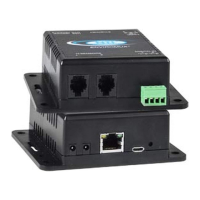NTI ENTERPRISE ENVIRONMENT MONITORING SYSTEM
45
Alert Settings
Alert Delay: The alert delay is an amount of time the sensor must be in an alert condition before an alert is sent. This provides
some protection against false alarms. The Alert Delay value can be set for 0-999 seconds or minutes.
Example:
The maximum threshold of a temperature sensor is 90 F, and the temperature of the monitored area is fluctuating between 88 and
91 degrees:
Reading #
(taken 1/ second)
Value Action (with delay set
@ 3 seconds
1 88F
2 89F
3 90F Ignored
4 89F
5 90F Ignored
6 89F
7 90F Ignored
8 90F Ignored
9 90F Alert sent
10 89F
The sensor is in an alert condition in Reading 3 but is back within the acceptable range in Reading 4. At Reading 5, the sensor is
in an alert condition again. Without the Alert Delay set, alerts will be sent for both Reading 3 and Reading 5. If the Alert Delay had
been set to 3 seconds, an alert would only be sent if the sensor had made three consecutive readings in an alert condition (since
readings are made every second). In this case, an alert will not be sent until Reading 9.
Alert Notifications
The alert can be configured to notify one or more users via e-mail, SNMP traps (v1,v2c,v3), Syslog messages, or SMS alerts.
The e-mail subject line for e-mail notification can be customized for easy source identification. The alert can activate an audible
siren, or an alarm beacon. Alerts are also indicated on the "Int Alert" or "Ext Alert " LEDs on the front of the ENVIROMUX and in
the WEB interface.
External sensors have the added feature of being able to be associated with an IP camera. If a checkmark is added to the block
“Attach IP camera capture to email” and an IP camera is selected from the drop-down box, an image will be captured and sent
with the alert message when an alert is sent via e-mail. IP cameras that are monitored by the ENVIROMUX (page 61) will be
available for this purpose.
Note: To be able to send IP camera captures as e-mail attachments, viewer security (in your camera’s configuration)
needs to be disabled. Consult your IP camera manual to see if this feature is present and for instructions on how to do
this.
If a checkmark is added to “Save Image to USB”, the image captured by the IP camera will also be saved to a flash drive
connected to a USB port.
Thresholds
Minimum Threshold: The user must define the lowest acceptable value for the sensors. If the sensor measures a value below
this threshold, the sensor will move to alert status. The assigned value should be within the range defined by Minimum Level and
Maximum Level and lower than the assigned Maximum Threshold value. If values out of the range are entered, they will be
automatically adjusted to be within range.
Maximum Threshold: The user must define the highest acceptable value for the sensors. If the sensor measures a value above
this threshold, the sensor will move to alert status. The assigned value should be within the range defined by Minimum Level and
Maximum Level and higher than the assigned Minimum Threshold value. If values out of the range are entered, they will be
automatically adjusted to be within range.
Outputs
Each sensor can be associated with one of the connections labeled "Output Relays" (see page 23), and that connection can be
set to open or close the contacts of the relay either on alert, or when returning to normal. The tamper can also block the output
command generated by the alert. In this way other devices can be controlled by sensor and tamper alerts.

